Comprehensive System Analysis and Design Report: Health Record System
VerifiedAdded on 2021/04/24
|8
|1602
|27
Report
AI Summary
This report provides a detailed system analysis and design of the "My Health Record" system, an electronic health record initiative in Australia. It begins by outlining the problems associated with traditional paper-based health records, such as storage limitations, data damage, accessibility issues, and geographical barriers to healthcare. The report then explores the system's capabilities, including integrated data storage, 24/7 patient-physician connectivity, enhanced data security through encryption, and improved data accessibility via digital devices. Finally, the report highlights the benefits of the system, such as direct access to patient information for physicians, increased efficiency in record-keeping, improved system accessibility, and the elimination of data inconsistencies and duplication. The report concludes that the implementation of the "My Health Record" system is a beneficial solution for both patients and physicians, recommending project initiation given existing funding and emphasizing the importance of patient data confidentiality.

Running head: SYSTEM ANALYSIS AND DESIGN
System Analysis and Design
Name of the Student
Name of the University
Author Note
System Analysis and Design
Name of the Student
Name of the University
Author Note
Paraphrase This Document
Need a fresh take? Get an instant paraphrase of this document with our AI Paraphraser
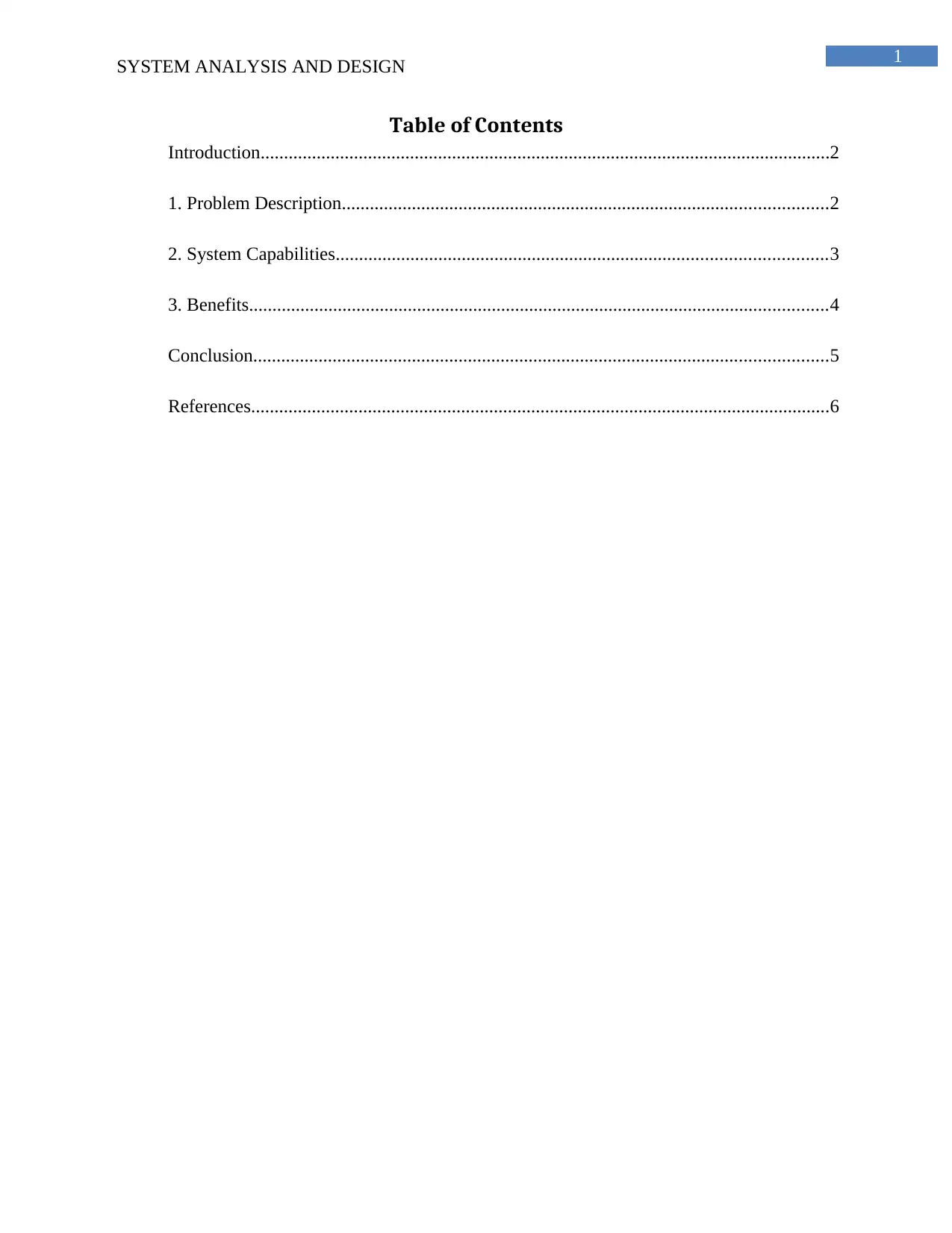
1
SYSTEM ANALYSIS AND DESIGN
Table of Contents
Introduction..........................................................................................................................2
1. Problem Description........................................................................................................2
2. System Capabilities.........................................................................................................3
3. Benefits............................................................................................................................4
Conclusion...........................................................................................................................5
References............................................................................................................................6
SYSTEM ANALYSIS AND DESIGN
Table of Contents
Introduction..........................................................................................................................2
1. Problem Description........................................................................................................2
2. System Capabilities.........................................................................................................3
3. Benefits............................................................................................................................4
Conclusion...........................................................................................................................5
References............................................................................................................................6
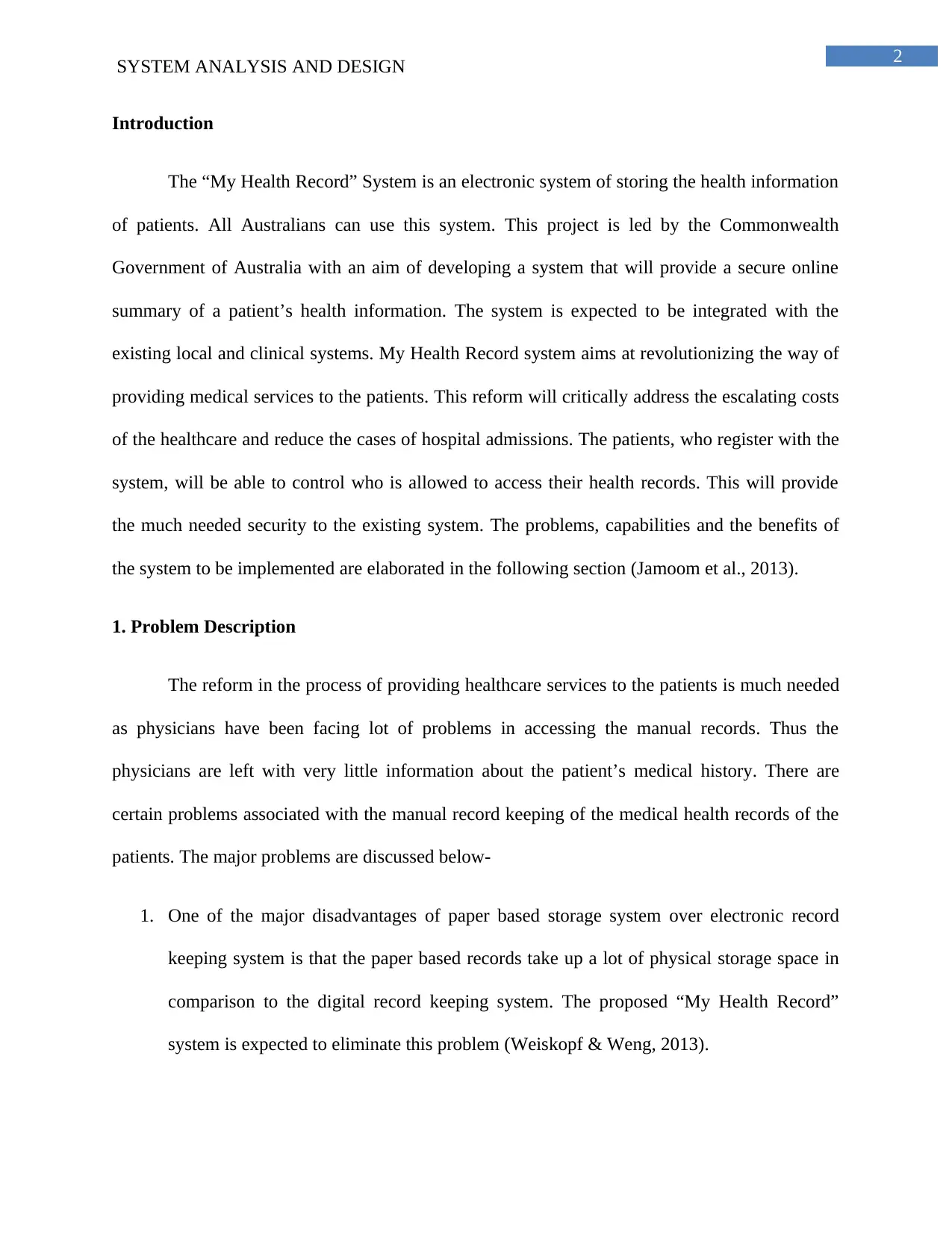
2
SYSTEM ANALYSIS AND DESIGN
Introduction
The “My Health Record” System is an electronic system of storing the health information
of patients. All Australians can use this system. This project is led by the Commonwealth
Government of Australia with an aim of developing a system that will provide a secure online
summary of a patient’s health information. The system is expected to be integrated with the
existing local and clinical systems. My Health Record system aims at revolutionizing the way of
providing medical services to the patients. This reform will critically address the escalating costs
of the healthcare and reduce the cases of hospital admissions. The patients, who register with the
system, will be able to control who is allowed to access their health records. This will provide
the much needed security to the existing system. The problems, capabilities and the benefits of
the system to be implemented are elaborated in the following section (Jamoom et al., 2013).
1. Problem Description
The reform in the process of providing healthcare services to the patients is much needed
as physicians have been facing lot of problems in accessing the manual records. Thus the
physicians are left with very little information about the patient’s medical history. There are
certain problems associated with the manual record keeping of the medical health records of the
patients. The major problems are discussed below-
1. One of the major disadvantages of paper based storage system over electronic record
keeping system is that the paper based records take up a lot of physical storage space in
comparison to the digital record keeping system. The proposed “My Health Record”
system is expected to eliminate this problem (Weiskopf & Weng, 2013).
SYSTEM ANALYSIS AND DESIGN
Introduction
The “My Health Record” System is an electronic system of storing the health information
of patients. All Australians can use this system. This project is led by the Commonwealth
Government of Australia with an aim of developing a system that will provide a secure online
summary of a patient’s health information. The system is expected to be integrated with the
existing local and clinical systems. My Health Record system aims at revolutionizing the way of
providing medical services to the patients. This reform will critically address the escalating costs
of the healthcare and reduce the cases of hospital admissions. The patients, who register with the
system, will be able to control who is allowed to access their health records. This will provide
the much needed security to the existing system. The problems, capabilities and the benefits of
the system to be implemented are elaborated in the following section (Jamoom et al., 2013).
1. Problem Description
The reform in the process of providing healthcare services to the patients is much needed
as physicians have been facing lot of problems in accessing the manual records. Thus the
physicians are left with very little information about the patient’s medical history. There are
certain problems associated with the manual record keeping of the medical health records of the
patients. The major problems are discussed below-
1. One of the major disadvantages of paper based storage system over electronic record
keeping system is that the paper based records take up a lot of physical storage space in
comparison to the digital record keeping system. The proposed “My Health Record”
system is expected to eliminate this problem (Weiskopf & Weng, 2013).
⊘ This is a preview!⊘
Do you want full access?
Subscribe today to unlock all pages.

Trusted by 1+ million students worldwide
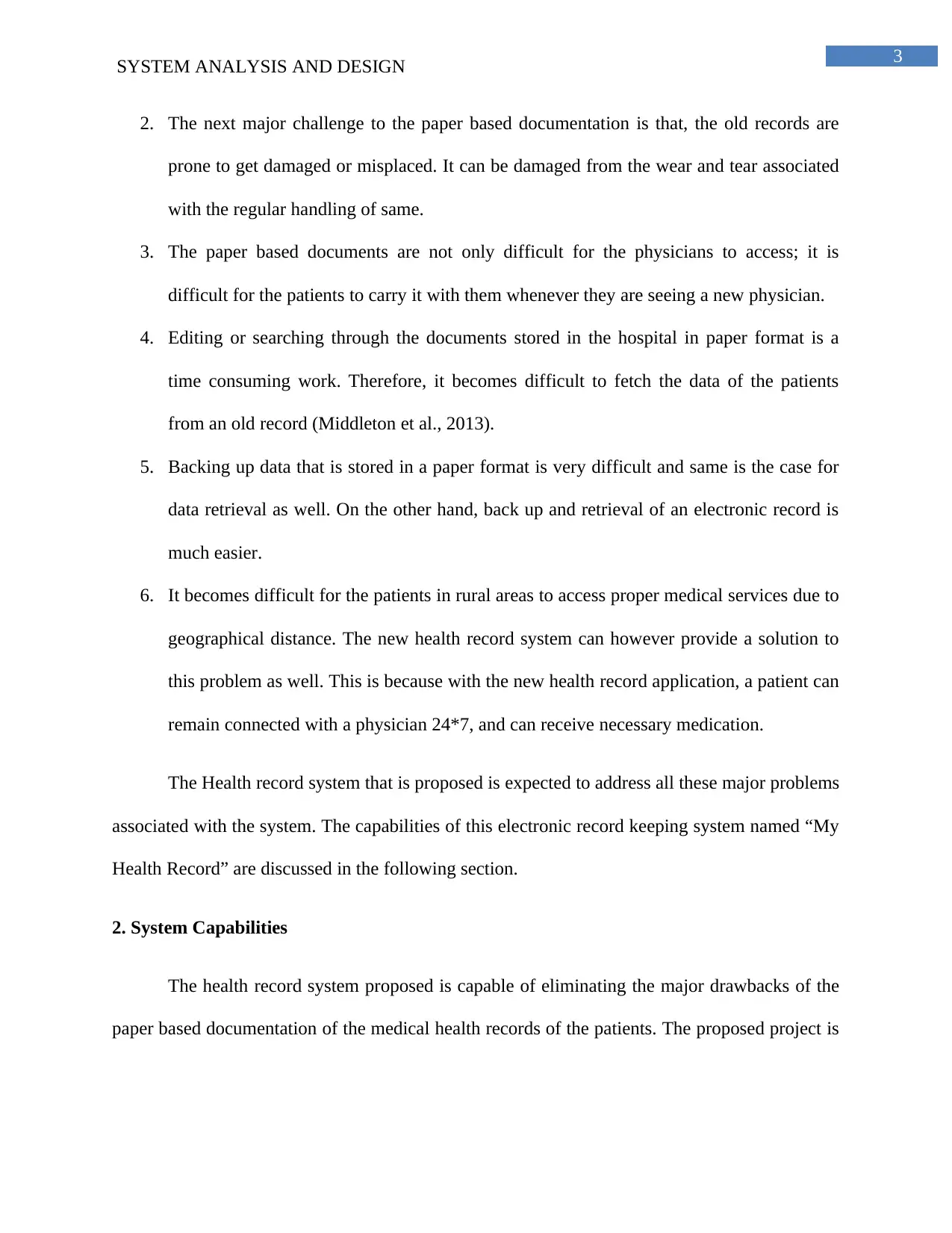
3
SYSTEM ANALYSIS AND DESIGN
2. The next major challenge to the paper based documentation is that, the old records are
prone to get damaged or misplaced. It can be damaged from the wear and tear associated
with the regular handling of same.
3. The paper based documents are not only difficult for the physicians to access; it is
difficult for the patients to carry it with them whenever they are seeing a new physician.
4. Editing or searching through the documents stored in the hospital in paper format is a
time consuming work. Therefore, it becomes difficult to fetch the data of the patients
from an old record (Middleton et al., 2013).
5. Backing up data that is stored in a paper format is very difficult and same is the case for
data retrieval as well. On the other hand, back up and retrieval of an electronic record is
much easier.
6. It becomes difficult for the patients in rural areas to access proper medical services due to
geographical distance. The new health record system can however provide a solution to
this problem as well. This is because with the new health record application, a patient can
remain connected with a physician 24*7, and can receive necessary medication.
The Health record system that is proposed is expected to address all these major problems
associated with the system. The capabilities of this electronic record keeping system named “My
Health Record” are discussed in the following section.
2. System Capabilities
The health record system proposed is capable of eliminating the major drawbacks of the
paper based documentation of the medical health records of the patients. The proposed project is
SYSTEM ANALYSIS AND DESIGN
2. The next major challenge to the paper based documentation is that, the old records are
prone to get damaged or misplaced. It can be damaged from the wear and tear associated
with the regular handling of same.
3. The paper based documents are not only difficult for the physicians to access; it is
difficult for the patients to carry it with them whenever they are seeing a new physician.
4. Editing or searching through the documents stored in the hospital in paper format is a
time consuming work. Therefore, it becomes difficult to fetch the data of the patients
from an old record (Middleton et al., 2013).
5. Backing up data that is stored in a paper format is very difficult and same is the case for
data retrieval as well. On the other hand, back up and retrieval of an electronic record is
much easier.
6. It becomes difficult for the patients in rural areas to access proper medical services due to
geographical distance. The new health record system can however provide a solution to
this problem as well. This is because with the new health record application, a patient can
remain connected with a physician 24*7, and can receive necessary medication.
The Health record system that is proposed is expected to address all these major problems
associated with the system. The capabilities of this electronic record keeping system named “My
Health Record” are discussed in the following section.
2. System Capabilities
The health record system proposed is capable of eliminating the major drawbacks of the
paper based documentation of the medical health records of the patients. The proposed project is
Paraphrase This Document
Need a fresh take? Get an instant paraphrase of this document with our AI Paraphraser
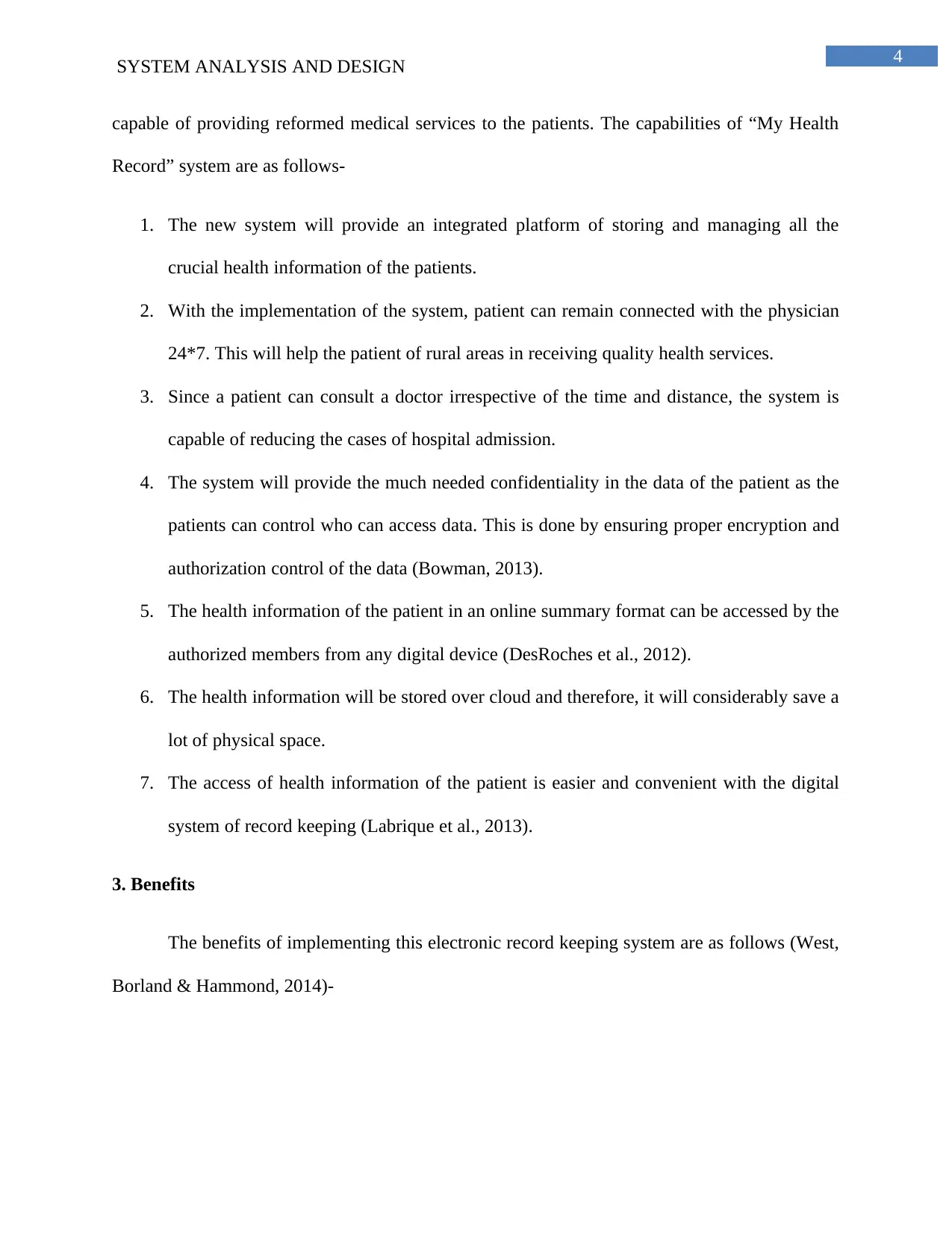
4
SYSTEM ANALYSIS AND DESIGN
capable of providing reformed medical services to the patients. The capabilities of “My Health
Record” system are as follows-
1. The new system will provide an integrated platform of storing and managing all the
crucial health information of the patients.
2. With the implementation of the system, patient can remain connected with the physician
24*7. This will help the patient of rural areas in receiving quality health services.
3. Since a patient can consult a doctor irrespective of the time and distance, the system is
capable of reducing the cases of hospital admission.
4. The system will provide the much needed confidentiality in the data of the patient as the
patients can control who can access data. This is done by ensuring proper encryption and
authorization control of the data (Bowman, 2013).
5. The health information of the patient in an online summary format can be accessed by the
authorized members from any digital device (DesRoches et al., 2012).
6. The health information will be stored over cloud and therefore, it will considerably save a
lot of physical space.
7. The access of health information of the patient is easier and convenient with the digital
system of record keeping (Labrique et al., 2013).
3. Benefits
The benefits of implementing this electronic record keeping system are as follows (West,
Borland & Hammond, 2014)-
SYSTEM ANALYSIS AND DESIGN
capable of providing reformed medical services to the patients. The capabilities of “My Health
Record” system are as follows-
1. The new system will provide an integrated platform of storing and managing all the
crucial health information of the patients.
2. With the implementation of the system, patient can remain connected with the physician
24*7. This will help the patient of rural areas in receiving quality health services.
3. Since a patient can consult a doctor irrespective of the time and distance, the system is
capable of reducing the cases of hospital admission.
4. The system will provide the much needed confidentiality in the data of the patient as the
patients can control who can access data. This is done by ensuring proper encryption and
authorization control of the data (Bowman, 2013).
5. The health information of the patient in an online summary format can be accessed by the
authorized members from any digital device (DesRoches et al., 2012).
6. The health information will be stored over cloud and therefore, it will considerably save a
lot of physical space.
7. The access of health information of the patient is easier and convenient with the digital
system of record keeping (Labrique et al., 2013).
3. Benefits
The benefits of implementing this electronic record keeping system are as follows (West,
Borland & Hammond, 2014)-
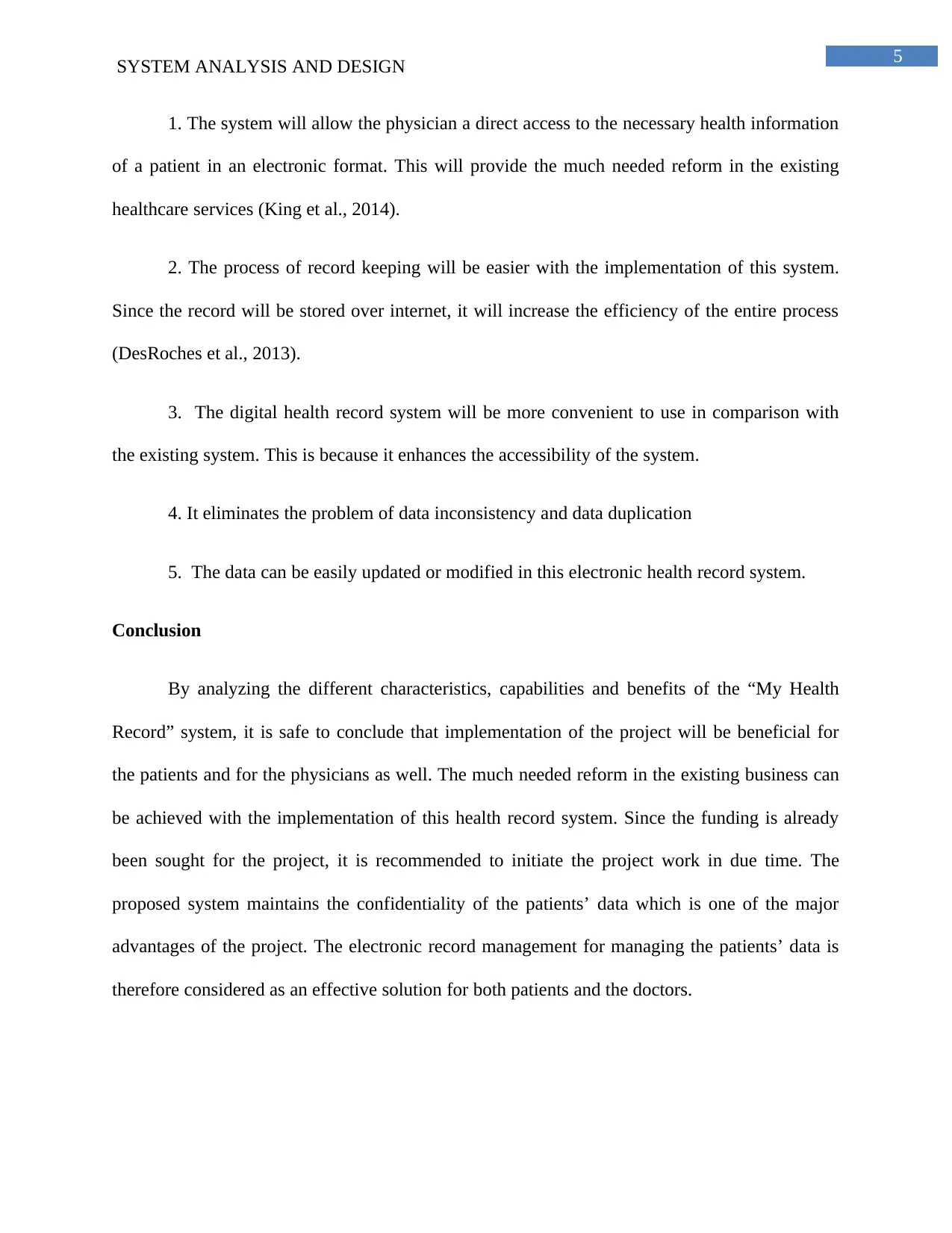
5
SYSTEM ANALYSIS AND DESIGN
1. The system will allow the physician a direct access to the necessary health information
of a patient in an electronic format. This will provide the much needed reform in the existing
healthcare services (King et al., 2014).
2. The process of record keeping will be easier with the implementation of this system.
Since the record will be stored over internet, it will increase the efficiency of the entire process
(DesRoches et al., 2013).
3. The digital health record system will be more convenient to use in comparison with
the existing system. This is because it enhances the accessibility of the system.
4. It eliminates the problem of data inconsistency and data duplication
5. The data can be easily updated or modified in this electronic health record system.
Conclusion
By analyzing the different characteristics, capabilities and benefits of the “My Health
Record” system, it is safe to conclude that implementation of the project will be beneficial for
the patients and for the physicians as well. The much needed reform in the existing business can
be achieved with the implementation of this health record system. Since the funding is already
been sought for the project, it is recommended to initiate the project work in due time. The
proposed system maintains the confidentiality of the patients’ data which is one of the major
advantages of the project. The electronic record management for managing the patients’ data is
therefore considered as an effective solution for both patients and the doctors.
SYSTEM ANALYSIS AND DESIGN
1. The system will allow the physician a direct access to the necessary health information
of a patient in an electronic format. This will provide the much needed reform in the existing
healthcare services (King et al., 2014).
2. The process of record keeping will be easier with the implementation of this system.
Since the record will be stored over internet, it will increase the efficiency of the entire process
(DesRoches et al., 2013).
3. The digital health record system will be more convenient to use in comparison with
the existing system. This is because it enhances the accessibility of the system.
4. It eliminates the problem of data inconsistency and data duplication
5. The data can be easily updated or modified in this electronic health record system.
Conclusion
By analyzing the different characteristics, capabilities and benefits of the “My Health
Record” system, it is safe to conclude that implementation of the project will be beneficial for
the patients and for the physicians as well. The much needed reform in the existing business can
be achieved with the implementation of this health record system. Since the funding is already
been sought for the project, it is recommended to initiate the project work in due time. The
proposed system maintains the confidentiality of the patients’ data which is one of the major
advantages of the project. The electronic record management for managing the patients’ data is
therefore considered as an effective solution for both patients and the doctors.
⊘ This is a preview!⊘
Do you want full access?
Subscribe today to unlock all pages.

Trusted by 1+ million students worldwide
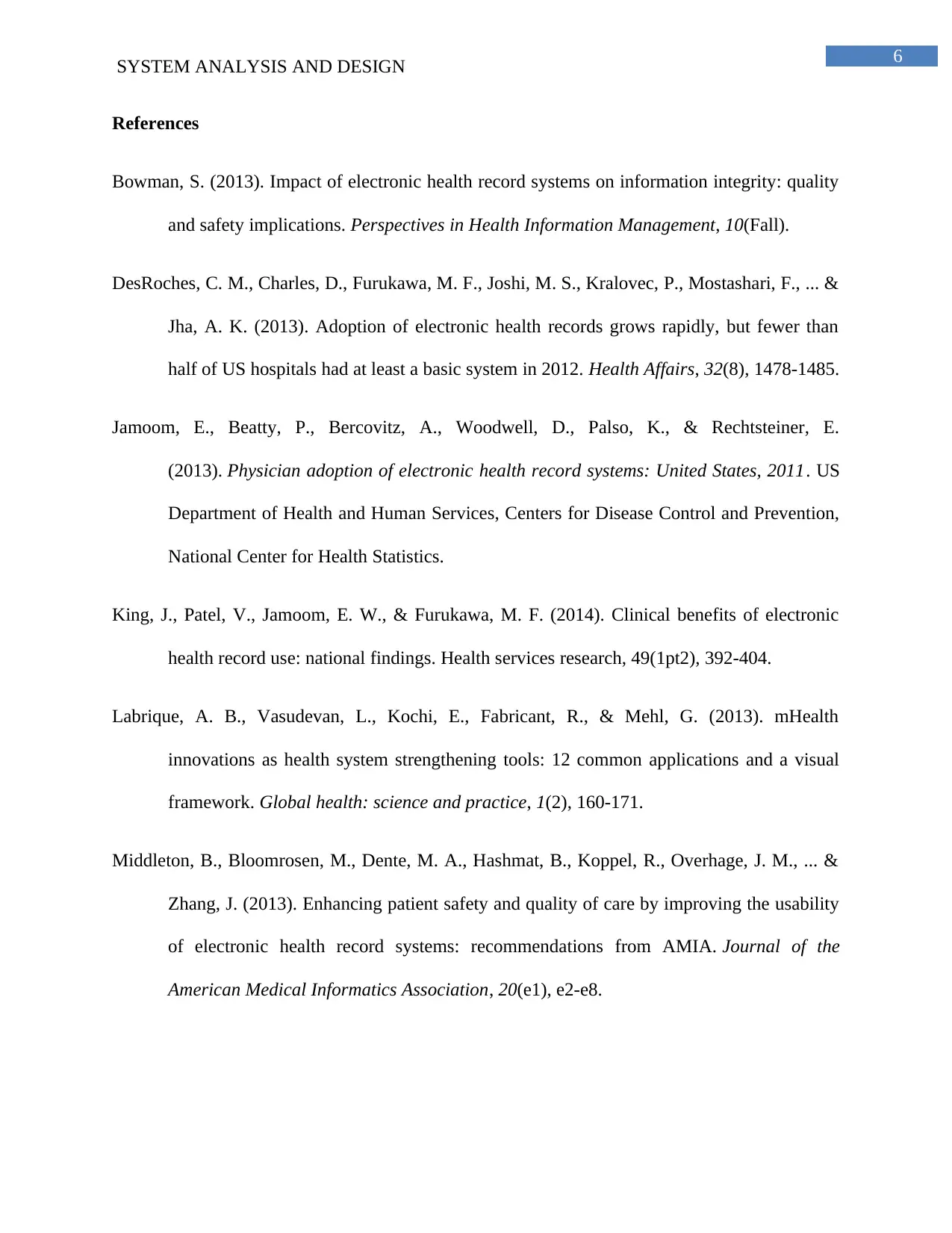
6
SYSTEM ANALYSIS AND DESIGN
References
Bowman, S. (2013). Impact of electronic health record systems on information integrity: quality
and safety implications. Perspectives in Health Information Management, 10(Fall).
DesRoches, C. M., Charles, D., Furukawa, M. F., Joshi, M. S., Kralovec, P., Mostashari, F., ... &
Jha, A. K. (2013). Adoption of electronic health records grows rapidly, but fewer than
half of US hospitals had at least a basic system in 2012. Health Affairs, 32(8), 1478-1485.
Jamoom, E., Beatty, P., Bercovitz, A., Woodwell, D., Palso, K., & Rechtsteiner, E.
(2013). Physician adoption of electronic health record systems: United States, 2011. US
Department of Health and Human Services, Centers for Disease Control and Prevention,
National Center for Health Statistics.
King, J., Patel, V., Jamoom, E. W., & Furukawa, M. F. (2014). Clinical benefits of electronic
health record use: national findings. Health services research, 49(1pt2), 392-404.
Labrique, A. B., Vasudevan, L., Kochi, E., Fabricant, R., & Mehl, G. (2013). mHealth
innovations as health system strengthening tools: 12 common applications and a visual
framework. Global health: science and practice, 1(2), 160-171.
Middleton, B., Bloomrosen, M., Dente, M. A., Hashmat, B., Koppel, R., Overhage, J. M., ... &
Zhang, J. (2013). Enhancing patient safety and quality of care by improving the usability
of electronic health record systems: recommendations from AMIA. Journal of the
American Medical Informatics Association, 20(e1), e2-e8.
SYSTEM ANALYSIS AND DESIGN
References
Bowman, S. (2013). Impact of electronic health record systems on information integrity: quality
and safety implications. Perspectives in Health Information Management, 10(Fall).
DesRoches, C. M., Charles, D., Furukawa, M. F., Joshi, M. S., Kralovec, P., Mostashari, F., ... &
Jha, A. K. (2013). Adoption of electronic health records grows rapidly, but fewer than
half of US hospitals had at least a basic system in 2012. Health Affairs, 32(8), 1478-1485.
Jamoom, E., Beatty, P., Bercovitz, A., Woodwell, D., Palso, K., & Rechtsteiner, E.
(2013). Physician adoption of electronic health record systems: United States, 2011. US
Department of Health and Human Services, Centers for Disease Control and Prevention,
National Center for Health Statistics.
King, J., Patel, V., Jamoom, E. W., & Furukawa, M. F. (2014). Clinical benefits of electronic
health record use: national findings. Health services research, 49(1pt2), 392-404.
Labrique, A. B., Vasudevan, L., Kochi, E., Fabricant, R., & Mehl, G. (2013). mHealth
innovations as health system strengthening tools: 12 common applications and a visual
framework. Global health: science and practice, 1(2), 160-171.
Middleton, B., Bloomrosen, M., Dente, M. A., Hashmat, B., Koppel, R., Overhage, J. M., ... &
Zhang, J. (2013). Enhancing patient safety and quality of care by improving the usability
of electronic health record systems: recommendations from AMIA. Journal of the
American Medical Informatics Association, 20(e1), e2-e8.
Paraphrase This Document
Need a fresh take? Get an instant paraphrase of this document with our AI Paraphraser
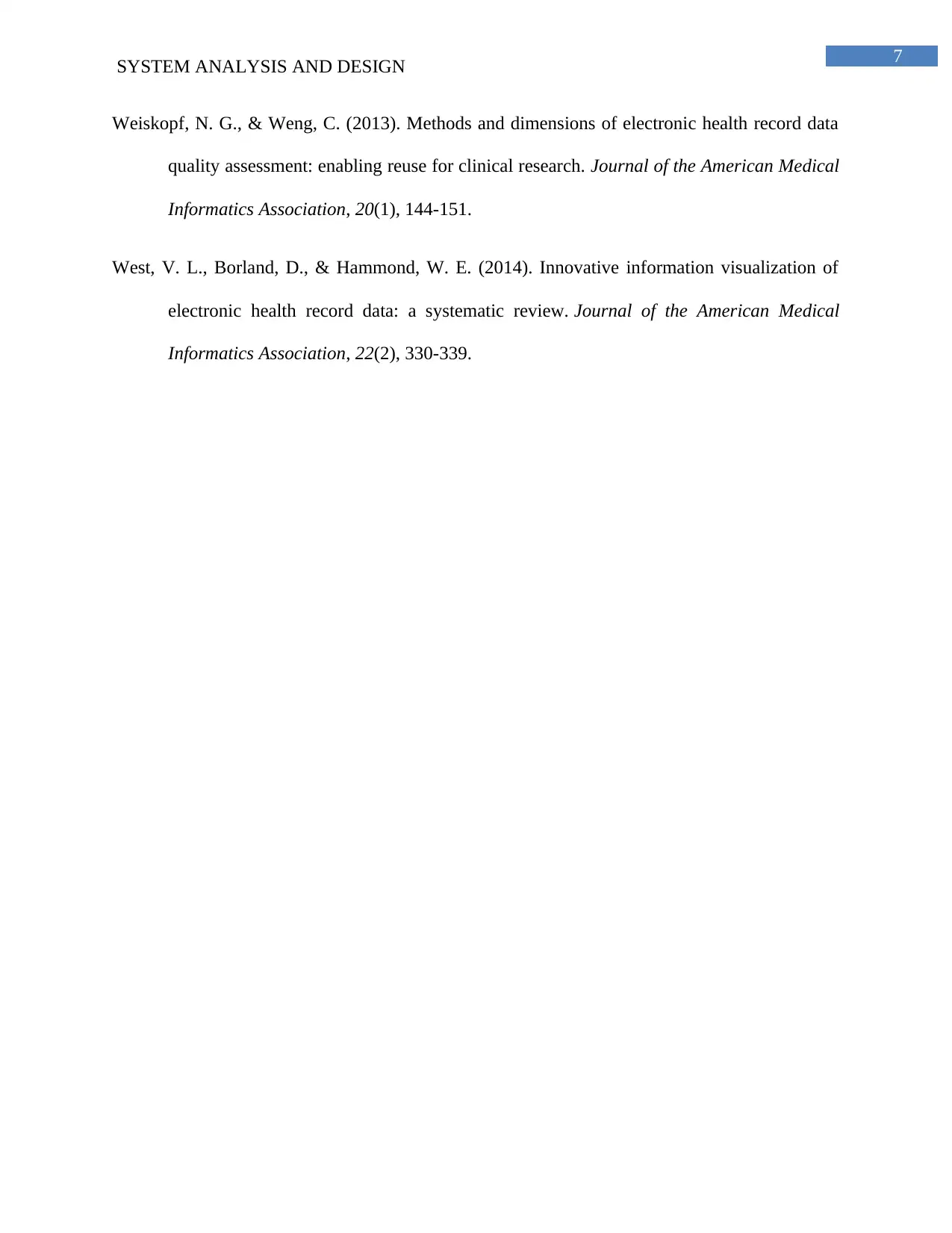
7
SYSTEM ANALYSIS AND DESIGN
Weiskopf, N. G., & Weng, C. (2013). Methods and dimensions of electronic health record data
quality assessment: enabling reuse for clinical research. Journal of the American Medical
Informatics Association, 20(1), 144-151.
West, V. L., Borland, D., & Hammond, W. E. (2014). Innovative information visualization of
electronic health record data: a systematic review. Journal of the American Medical
Informatics Association, 22(2), 330-339.
SYSTEM ANALYSIS AND DESIGN
Weiskopf, N. G., & Weng, C. (2013). Methods and dimensions of electronic health record data
quality assessment: enabling reuse for clinical research. Journal of the American Medical
Informatics Association, 20(1), 144-151.
West, V. L., Borland, D., & Hammond, W. E. (2014). Innovative information visualization of
electronic health record data: a systematic review. Journal of the American Medical
Informatics Association, 22(2), 330-339.
1 out of 8
Related Documents
Your All-in-One AI-Powered Toolkit for Academic Success.
+13062052269
info@desklib.com
Available 24*7 on WhatsApp / Email
![[object Object]](/_next/static/media/star-bottom.7253800d.svg)
Unlock your academic potential
Copyright © 2020–2025 A2Z Services. All Rights Reserved. Developed and managed by ZUCOL.





